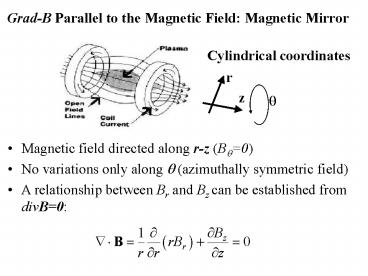GradB Parallel to the Magnetic Field: Magnetic Mirror - PowerPoint PPT Presentation
1 / 9
Title:
GradB Parallel to the Magnetic Field: Magnetic Mirror
Description:
... Parallel to the Magnetic Field: Magnetic Mirror. Magnetic Mirror (II): Particle ... Magnetic mirror: the parallel velocity can go to zero in high magnetic field ... – PowerPoint PPT presentation
Number of Views:294
Avg rating:3.0/5.0
Title: GradB Parallel to the Magnetic Field: Magnetic Mirror
1
Grad-B Parallel to the Magnetic Field Magnetic
Mirror
Cylindrical coordinates
r
z
q
- Magnetic field directed along r-z (Bq0)
- No variations only along q (azimuthally symmetric
field) - A relationship between Br and Bz can be
established from divB0
2
Magnetic Mirror (II) Particle Motion
- Approximation ?Bz/?z does not vary with r
- By solving with respect Br via integration with
respect r it is found
- The components of the Lorentz force in
cylindrical coordinates are
3
Magnetic Mirror (III) Particle Motion
- Axial force
- Orbit-averaging for a particle with guiding
center on the axis. In the chosen cylindrical
coordinates the azimuthal component of the
velocity will be negative for a positive charge.
therefore
4
Magnetic Mirror (IV) Invariance of Magnetic
Moment
- Define the magnetic moment for a gyrating
particle
then
- The magnetic moment for a gyrating particle
corresponds to the usual definition of magnetic
moment for a current loop enclosing an area
5
Magnetic Mirror (V) Invariance of Magnetic Moment
- The magnetic moment is an invariant for the
particle motion for a generic coordinate s
parallel to the magnetic field the equation of
motion along B is
by multiplying both members by vds/dt
(dB/dt is the variation of the field seen by
the particle)
6
Magnetic Mirror (VI) Invariance of Magnetic
Moment
- Conservation of energy
or
and finally
7
Magnetic Mirror (VII) Reflection
- As a consequence of the invariance of m the
particle must change its perpendicular
energy/velocity when the magnetic field changes - Higher magnetic field will require larger
perpendicular velocity - Conservation of energy then will require smaller
parallel energy/velocity - Magnetic mirror the parallel velocity can go to
zero in high magnetic field regions, then causing
the particle reflection - If the parallel velocity does not go to zero at
the highest magnetic field region the particle
exits the mirror
8
Magnetic Mirror (VIII) Loss Cone
- A particle in correspondence of the minimum B0
has velocity v0(v0, v-0) - The particle is being reflected in correspondence
of the maximum field Bm the velocity at the
reflection point will be vm(0, vm-) - Conservation of Energy implies
- The invariance magnetic moment requires
9
Magnetic Mirror (IX) Loss Cone
- By expressing everything in terms of the particle
velocity at the minimum B it is found
v-0
v0
q
v0
Loss Cone
- Mirror Ratio































